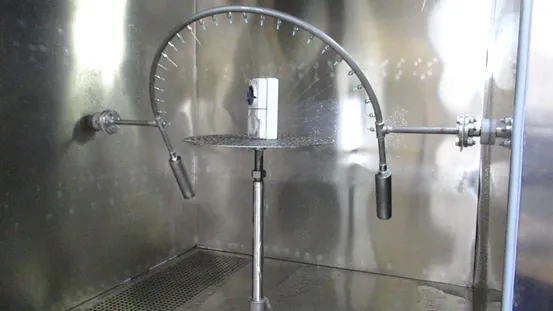Ingress Protection Testing
Understanding and ensuring the ingress protection of electronic devices is critical in many sectors where harsh environmental conditions are encountered. Ingress protection testing evaluates a device's ability to withstand exposure to foreign objects, dust particles, moisture, water jets, and other contaminants that can lead to malfunction or failure.
Ingress Protection (IP) ratings provide a standardized way for manufacturers and consumers to assess the level of protection offered by an electrical appliance. These ratings are based on two digits: the first digit indicates resistance to solid objects (such as dust), while the second digit denotes resistance to liquids. For example, IP67 means that a device is fully protected against dust and can operate in immersion up to 1 meter for 30 minutes.
Electronics used in industrial environments, automotive applications, outdoor installations, or even consumer electronics like smartphones need rigorous ingress protection testing. This ensures they perform reliably under various conditions without compromising safety standards. The importance of this testing becomes evident when considering that unprotected devices can suffer damage leading to costly repairs, product recalls, and potential hazards.
Proper IP rating selection depends on the specific environment in which a device will be used. For instance, outdoor equipment operating near bodies of water may require higher IP67 ratings compared to indoor office electronics which might only need IP20 protection against dust ingress. Additionally, newer technologies such as IoT devices and wearable tech present unique challenges requiring advanced testing methods beyond traditional standards.
Given the complexity involved in accurately determining appropriate levels of ingress protection, it is essential for organizations to partner with reputable laboratories capable of providing accurate and reliable results. By leveraging expertise from experienced professionals who stay abreast of industry trends and regulatory changes, businesses can ensure their products meet current requirements while anticipating future needs.
Why Choose This Test
- Ensures reliability in diverse operational environments.
- Promotes safety by preventing malfunctions due to environmental factors.
- Aids in compliance with international standards and regulations.
- Facilitates product longevity through enhanced durability against contaminants.
The benefits of choosing ingress protection testing are manifold. Firstly, it guarantees that electronic devices perform consistently across different operating conditions, thereby enhancing overall satisfaction among end users. Secondly, by ensuring products do not fail prematurely due to environmental exposure, manufacturers can minimize warranty claims and associated costs. Compliance with relevant international standards also strengthens brand reputation and fosters trust within the market. Lastly, improved durability contributes significantly towards extending product life cycles, ultimately leading to reduced expenses related to replacements or repairs.
Customer Impact and Satisfaction
- Prolongs device lifespan by protecting against environmental damage.
- Reduces risk of product failures resulting in costly repairs or recalls.
- Enhances reliability which leads to higher customer satisfaction levels.
- Ensures compliance with industry norms thereby boosting brand image.
The impact on customers is profound when considering the numerous advantages provided by effective ingress protection testing. Prolonging device lifespans not only saves money but also demonstrates a commitment to quality and sustainability, which resonates well with environmentally conscious consumers. Avoiding product failures reduces downtime associated with maintenance activities or replacements, thus saving time and resources for both manufacturers and users alike. Higher reliability translates into increased trust between companies and their customers, fostering long-term relationships built on mutual respect and satisfaction.
Use Cases and Application Examples
| Application | Protection Requirements | Testing Methodologies |
|---|---|---|
| Outdoor electrical equipment | IP67/IP68 | Water immersion tests, dust ingress tests. |
| Medical devices used in hospital settings | IP44 | Jet spray and splash water resistance tests. |
| Automotive electronics exposed to road salt | IP67/IP69K | Water pressure and steam cleaning tests. |
| Smartphones for outdoor activities like hiking | IPX5/IPX8 | Drip test, submersion depth verification. |
The application of ingress protection testing spans various industries and applications. Outdoor electrical equipment such as street lamps or traffic signals often face harsh weather conditions necessitating robust IP67/IP68 ratings to ensure continuous operation despite water immersion up to 1 meter for extended periods. For medical devices, particularly those used in hospitals where hygiene is paramount, IP44 ratings guarantee protection against splashing water and prevent cross-contamination. In automotive settings, especially with the rise of electric vehicles (EVs), EV batteries must withstand extreme environmental challenges including saltwater exposure during winter months; hence, IP67/IP69K ratings are crucial for achieving optimal performance.
In consumer electronics like smartphones designed for outdoor enthusiasts, ensuring water resistance at depths beyond 1 meter (IPX5/IPX8) is essential to meet user expectations without compromising safety. Each of these scenarios underscores the necessity of precise testing methodologies tailored to specific requirements ensuring not only compliance with international standards such as IEC 60529 but also exceeding them where necessary.





